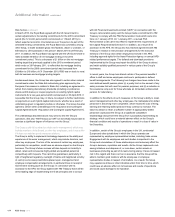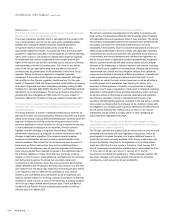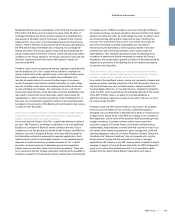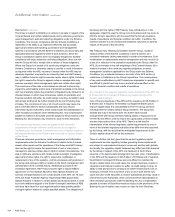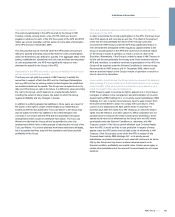RBS 2010 Annual Report Download - page 414
Download and view the complete annual report
Please find page 414 of the 2010 RBS annual report below. You can navigate through the pages in the report by either clicking on the pages listed below, or by using the keyword search tool below to find specific information within the annual report.Risk factors continued
The Basel Committee's package of reforms includes increasing the
minimum common equity requirement from 2% (before the application of
regulatory adjustments) to 4.5% (after the application of stricter regulatory
adjustments). The total Tier 1 capital requirement, which includes
common equity and other qualifying financial instruments, will increase
from 4% to 6%. The total capital requirement (which comprises Tier 1
capital and Tier 2 capital) remains at 8%. In addition, banks will be
required to maintain, in the form of common equity (after the application
of deductions), a capital conservation buffer of 2.5% to withstand future
periods of stress, bringing the total common equity requirements to 7%. If
there is excess credit growth in any given country resulting in a system-
wide build up of risk, a countercyclical buffer within a range of 0% to 2.5%
of common equity (or possibly other fully loss absorbing capital) is to be
applied as an extension of the conservation buffer. In addition, a leverage
ratio will be introduced, together with a liquidity coverage ratio and a net
stable funding ratio. The liquidity coverage ratio is intended to promote
resilience to potential liquidity stress scenarios lasting for a 30-day period.
The net stable funding ratio is intended to limit over reliance on short-
term wholesale funding and has been developed to provide a sustainable
maturity structure of assets and liabilities. The Basel Committee is
conducting further work on systemically important financial institutions
and contingent capital in close coordination with the Financial Stability
Board. The Basel Committee has stated that measures may include
capital surcharges, contingent capital and bail-in debt (which could be
introduced by statute, possibly impacting existing as well as future issues
of debt and exposing them to the risk of conversion into equity and/or
write-down of principal amount). Such measures would be in addition to
proposals for the write-off of Tier 1 and Tier 2 debt (and its possible
conversion into ordinary shares) if a bank becomes non-viable.
The Basel Committee is expected to complete by early to mid 2011 a
methodology for identifying global systemically important financial
institutions with a view to the Financial Stability Board and national
authorities determining by mid-2011 those institutions to which the
recommendations for global systemically important financial institutions
will initially apply. In addition, by mid-2011, the Basel Committee is to
complete a study of how much additional loss absorbency capacity global
systemically important financial institutions should have and how much of
such capacity could be provided by the various proposed instruments
(which include contingent capital securities and bail-in debt).
The implementation of the Basel III reforms will begin on 1 January 2013,
however the requirements are subject to a series of transitional
arrangements and will be phased in over a period of time, to be fully
effective by 2019.
To the extent the Group has estimated the indicative impact that Basel III
reforms may have on its RWAs and capital ratios, such estimates are
preliminary and subject to uncertainties and may change. In particular,
the estimates assume mitigating actions will be taken by the Group (such
as deleveraging of legacy positions and securitisations, including Non-
Core, as well as other actions being taken to derisk market and
counterparty exposures), which may not occur as anticipated, in a timely
manner, or at all.
The Basel Committee changes and other future changes to capital
adequacy and liquidity requirements in the UK and in other jurisdictions in
which it operates, including the European Commission’s public
consultation on further possible changes to the Capital Requirements
Directive launched in February 2010, may require the Group to raise
additional Tier 1 (including Core Tier 1) and Tier 2 capital by way of
further issuances of securities, including in the form of ordinary shares or
Bshares and will result in existing Tier 1 and Tier 2 securities issued by
the Group ceasing to count towards the Group’s regulatory capital, either
at the same level as present or at all. The requirement to raise additional
Core Tier 1 capital could have a number of negative consequences for
the company and its shareholders, including impairing the company’s
ability to pay dividends on or make other distributions in respect of
ordinary shares and diluting the ownership of existing shareholders of the
company. If the Group is unable to raise the requisite Tier 1 and Tier 2
capital, it may be required to further reduce the amount of its risk-
weighted assets and engage in the disposal of core and other Non-Core
businesses, which may not occur on a timely basis or achieve prices
which would otherwise be attractive to the Group. In addition, pursuant to
the State Aid approval, should the Group’s Core Tier 1 capital ratio
decline to below 5 per cent. at any time before 31 December 2014, or
should the Group fall short of its funded balance sheet target level (after
adjustments) for 31 December 2013 by £30 billion or more, the Group will
be required to reduce its risk-weighted assets by a further £60 billion in
excess of its plan through further disposals of identifiable businesses and
their associated assets. As provided in the Acquisition and Contingent
Capital Agreement (as defined below), the Group will also be subject to
restrictions on payments on its hybrid capital instruments should its Core
Tier 1 ratio fall below 6 per cent. or if it would fall below 6 per cent. as a
result of such payment.
As at 31 December 2010, the Group’s Tier 1 and Core Tier 1 capital
ratios were 12.9 per cent and 10.7 per cent., respectively, calculated in
accordance with FSA requirements. Any change that limits the Group’s
ability to manage effectively its balance sheet and capital resources going
forward (including, for example, reductions in profits and retained
earnings as a result of write-downs or otherwise, increases in risk-
weighted assets, delays in the disposal of certain assets or the inability to
syndicate loans as a result of market conditions, a growth in unfunded
pension exposures or otherwise) or to access funding sources, could
have a material adverse impact on its financial condition and regulatory
capital position or result in a loss of value in the securities.
RBS Group 2010412
Additional information continued














